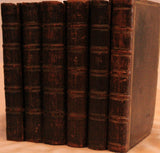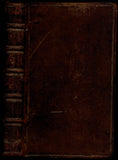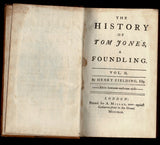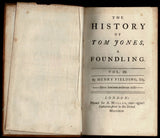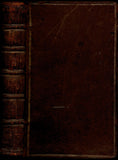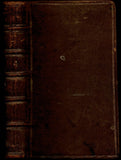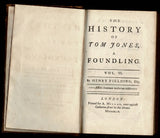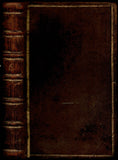The History of Tom Jones, a Foundling
Author: Henry Fielding (1707-1754)
Year: 1749
Publisher: Printed for Andrew Millar
Place: London
Description:
Six volumes. lxiii+[blank]+214 pages; [2 blank]+title=blank=324+[2 blank] pages; [2 blank]+title+[blank]+370+[2 blank] pages; [2 blank]+title+[blank]+312+[2 blank] pages; [2 blank]+title+[blank]+294+[2 blank] pages; [4 blank]+title+[blank]+304+[4 blank] pages. Duodecimo (6 3/4" x 4")bound in full uniform contemporary calf with five raised spine bands with gilt numbering to spine and gilt edges to covers. (ESTC T1947; Grolier English 48; Rothschild 850) First edition, first issue.
The History of Tom Jones, a Foundling, often known simply as Tom Jones, is a comic novel by English playwright and novelist Henry Fielding. It is a Bildungsroman and a picaresque novel. It was first published on 28 February 1749 in London and is among the earliest English works to be classified as a novel.
The novel is highly organized despite its length. Samuel Taylor Coleridge argued that it has one of the "three most perfect plots ever planned", alongside Oedipus Tyrannus and The Alchemist. It became a best seller with four editions published in its first year alone. It is generally regarded as Fielding's greatest book and as an influential English novel.
Fielding presents a panorama of contemporary British life, drawing characters from many different classes and occupations. But Ian Watt argues in The Rise of the Novel that Fielding did not aim at the "realism of presentation" of lifelike detail and psychology practiced by authors such as Richardson. Watt claims that Fielding was more focused on the "realism of assessment", the way in which the novel engages a broad range of topics with intelligence and "a wise assessment of life" The novel takes place against the backdrop of the Jacobite rising of 1745. Characters take different sides over the rebellion, which was an attempt to restore Roman Catholicism as the established religion of England and to undo the Glorious Revolution. At one point Sophia Western is even mistaken for Jenny Cameron, the supposed lover of Bonnie Prince Charlie. Good-natured characters are often moderately loyalist and Anglican, or even supporters of the House of Hanover, while ill-natured characters (Mrs Western) or mistaken ones (Partridge) can be Jacobites, or (like Squire Western) anti-Hanoverian.
William Wrightson of Cusworth, Yorkshire, was a British landowner and politician who sat in the House of Commons from 1784 to 1790. Wrightson was the son of John Battie originally of Sprotborough, Yorkshire and his wife Isabella Wrightson, daughter of William Wrightson of Cusworth Hall. Battie took name of Wrightson in 1766 on inheriting Cusworth Hall). Wrightson was educated at Christ Church, Oxford and Lincoln's Inn and succeeded his father to the Cusworth estate in 1785. Wrightson was elected MP for Aylesbury at the 1784 British general election, sitting until 1790. He was appointed High Sheriff of Yorkshire for 1819–20.
Condition:
Somewhat worn, bindings rubbed and scuffed spine ends rubbed, corners bumped and rubbed through, lacks front free end paper volume one. Former copy William Wrightson (1752-1827) of Cusworth in Yorkshire, with engraved armorial bookplates in the first two volumes, Wrightson's signature in others; also former copy Virginia bibliophile Christopher Clark Geest (1936-2023) with his book plates else good to very good.















